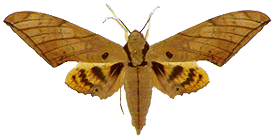Ambulyx pryeri Distant
Ambulyx pryeri Distant, 1887, Ann. Mag. nat. Hist., (5) 20: 271.
Ambulyx eteocles Huwe, 1895, Berl. ent. Zeitschr., 40: 367.
Oxyambulyx sumatranus Rothschild, 1920, Ann. Mag. nat. Hist.(9), 5: 479.
Oxyambulyx pryeri Distant; Diehl, 1980: 21
|

Ambulyx pryeri 
(.65
natural size)
|
Diagnosis. This species has heavy, broad banding to the hindwing and,
compared to the next species, a more or less even dark brown line from the
costa to the margin, distally coincided with vein M3. In clavata this line
is angled slightly at the end of the cell, broadening from that point
towards the costa; both subbasal dark patches are present, though the
anterior one may be weak; the hindwing markings are very narrow. The male
genitalia are very similar to those of clavata but the dorsal process of
the harpe is significantly shorter than the ventral process in clavata,
only slightly so in pryeri; clavata lacks the strong rugose subventral
flange of pryeri, and has the two processes more at right angles to each
other. In pryeri the non-serrate apical process of the aedeagus is much
(cf
only slightly) longer than the serrate ones and not bulbous apically; the
distal cornutus is longer, more slender, lacking the serrations seen in clavata.
Geographical range. Sundaland.
Habitat preference. The species is frequent from the lowlands to 2600m.
Biology. Barlow (1982) gave the host-plant as Plumeria (Apocynaceae).
<<Back
>>Forward <<Return
to Contents page
|

